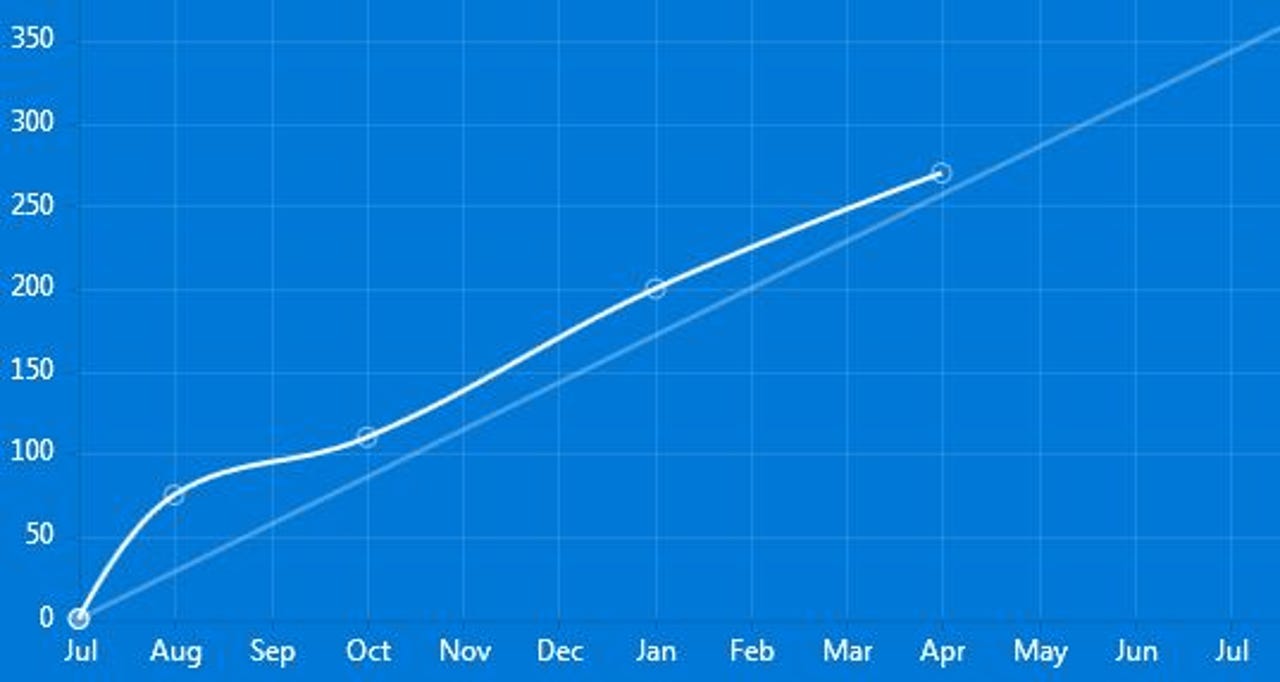Windows 10 is on track for a billion users, but do independent stats confirm Microsoft's numbers?


(Image: ZDNet)
In the opening keynote at Microsoft's Build conference in San Francisco, Terry Myerson announced that Windows 10 was now running on 270 million devices, as my colleague Ed Bott reported. Web developer Michael Gillett duly entered the number into his progress-tracking site (above), which shows that Windows 10 is running slightly ahead of target to reach a billion users in three years.
But is Microsoft's claim confirmed by the stats from NetMarketShare and StatCounter? Let's look at the numbers.
In the March results published on April 1, NetMarketShare credits Windows 10 with a market share of 14.15 percent. This shows above-average growth - 1.33 points - from February's figure, which was 12.82 percent.
Unfortunately, we have to guess how many active PCs there are, because nobody knows. However, it's generally accepted that there are around 1.5bn or 1.6bn, and you can adjust the total if you think it's too high or too low.
If we assume it's 1.6bn, then each percentage point represents 16m PCs, so 14.15 percent represents 226.4 million PCs. This is some way short of 270 million. In fact, on NetMarketShare numbers, we wouldn't expect to reach 270m for another couple of months.
StatCounter comes much closer. StatCounter's monthly figures give Windows 10 a usage share of 16.85 percent. Assuming there are 1.6bn PCs, this implies that 269.6 million PCs are running Windows 10, which is within a rounding error of Microsoft's claim.
On the other hand, StatCounter shows no significant growth from its March figure of 16.53 percent. That probably should not be the case, because this year, Microsoft extended its upgrades to domain-attached PCs, leading to some "unexpected" installations.
Of course, the stats are not directly comparable because the two companies are measuring different things. NetMarketShare is counting unique users, based on website visits, whereas StatCounter is counting website visits. People who spend all day on the web will be counted more often than those who use it once a week or once a month. In both cases, PCs restricted to corporate intranets, or permanently offline, won't be counted at all.
NetMarketShare balances its numbers to reflect global usage, which obviously varies from country to country. For example, Windows 10 has roughly twice the market share in the USA as it does in China, where (according to StatCounter), Windows XP still has 25 percent of the market.
Further, Microsoft has introduced another unknown by using the word "devices". This is perfectly reasonable because Windows 10 is a converged operating system that runs on PCs and tablets, smartphones, and the Xbox One games console, not to mention there's an Internet of Things version. There probably aren't a lot of non-PC devices running Windows 10 at the moment, but it does mean that counting PCs is no longer enough.
It will be interesting to see what happens to NetMarketShare's numbers over the next six months, especially after Microsoft stops offering free upgrades. A widening divergence between Microsoft's numbers and NetMarketShare's is bound to raise suspicions.
Update: There's some debate about whether the 1.6bn total includes Macs and Linux machines, or not. I assumed it did: they're all PCs. Either way, I generally take the view that 90m Macs doesn't really make any difference to the total, which is a guess at best.
However, Ed Bott tells me that if you strip the non-Windows machines out of NetMarketShare's numbers, Windows 10's market share rises to 15.6 percent (and Windows 7's to more than 57 percent). That would increase the number of Windows 10 PCs from 226.4m to 249.6m.